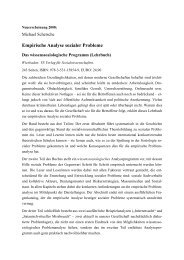Psychophysiology of False Memories in a Deese-Roediger ... - IGPP
Psychophysiology of False Memories in a Deese-Roediger ... - IGPP
Psychophysiology of False Memories in a Deese-Roediger ... - IGPP
You also want an ePaper? Increase the reach of your titles
YUMPU automatically turns print PDFs into web optimized ePapers that Google loves.
<strong>Psychophysiology</strong> <strong>of</strong> Visual <strong>False</strong> <strong>Memories</strong><br />
30. Barry RJ (1988) Significance and components <strong>of</strong> the orient<strong>in</strong>g response: effects <strong>of</strong><br />
signal value versus vigilance. Int J Psychophysiol 6(4): 343–346.<br />
31. Bernste<strong>in</strong> AS (1979) The orient<strong>in</strong>g response as novelty and significance detector:<br />
reply to O’Gorman. <strong>Psychophysiology</strong> 16(3): 263–273.<br />
32. Maltzman I (1979) Orient<strong>in</strong>g Reflexes and Significance: A Reply to O’Gorman.<br />
<strong>Psychophysiology</strong> 16(3): 274–282.<br />
33. Sokolov EN (1963) Perception and the conditioned reflex. New York:<br />
Macmillan.<br />
34. Barry RJ (2009) Habituation <strong>of</strong> the orient<strong>in</strong>g reflex and the development <strong>of</strong><br />
Prelim<strong>in</strong>ary Process Theory. Neurobiology <strong>of</strong> learn<strong>in</strong>g and memory 92(2):<br />
235–242.<br />
35. Bernste<strong>in</strong> AS, Taylor KW, We<strong>in</strong>ste<strong>in</strong> E, Riedel J (1985) The effect <strong>of</strong> stimulus<br />
significance on relatively susta<strong>in</strong>ed (tonic-like) and relatively transient (phasiclike)<br />
aspects <strong>of</strong> electrodermal, heart rate, and eyebl<strong>in</strong>k response. Biological<br />
Psychology 21(3): 183–228.<br />
36. Ben-Shakhar G (1994) The roles <strong>of</strong> stimulus novelty and significance <strong>in</strong><br />
determ<strong>in</strong><strong>in</strong>g the electrodermal orient<strong>in</strong>g response: Interactive versus additive<br />
approaches. <strong>Psychophysiology</strong> 31(4): 402–411.<br />
37. Ben-Shakhar G, Asher T, Poznansky-Levy A, Asherowitz R, Lieblich I (1989)<br />
Stimulus Novelty and Significance as Determ<strong>in</strong>ants <strong>of</strong> Electrodermal Responsivity:<br />
The Serial Position Effect. <strong>Psychophysiology</strong> 26(1): 29–38.<br />
38. Gati I, Ben-Shakhar G (1990) Novelty and significance <strong>in</strong> orientation and<br />
habituation: a feature-match<strong>in</strong>g approach. Journal <strong>of</strong> Experimental Psychology:<br />
General 119(3): 251–263.<br />
39. Gati I, Ben-Shakhar G, Avni-Liberty S (1996) Stimulus novelty and significance<br />
<strong>in</strong> electrodermal orient<strong>in</strong>g responses: The effects <strong>of</strong> add<strong>in</strong>g versus delet<strong>in</strong>g<br />
stimulus components. <strong>Psychophysiology</strong> 33(6): 637–643.<br />
40. Lykken DT (1974) Psychology and the lie detector <strong>in</strong>dustry. American<br />
Psychologist 29(10): 725–739.<br />
41. Verschuere B, Crombez G, Clercq A, Koster EHW (2004) Autonomic and<br />
behavioral respond<strong>in</strong>g to concealed <strong>in</strong>formation: Differentiat<strong>in</strong>g orient<strong>in</strong>g and<br />
defensive responses. <strong>Psychophysiology</strong> 41(3): 461–466.<br />
42. Verschuere B, Ben-Shakhar G, Meijer E, eds. (2011) Memory Detection: Theory<br />
and Application <strong>of</strong> the Concealed Information Test: Cambridge University Press.<br />
43. Lykken DT (1959) The GSR <strong>in</strong> the detection <strong>of</strong> guilt. Journal <strong>of</strong> Applied<br />
Psychology 43: 385–388.<br />
44. Ambach W, Stark R, Peper M, Vaitl D (2008) Separat<strong>in</strong>g deceptive and<br />
orient<strong>in</strong>g components <strong>in</strong> a Concealed Information Test. International Journal <strong>of</strong><br />
<strong>Psychophysiology</strong> 70(2): 95–104.<br />
45. Elaad E, Ben-Shakhar G (2006) F<strong>in</strong>ger pulse waveform length <strong>in</strong> the detection <strong>of</strong><br />
concealed <strong>in</strong>formation. International Journal <strong>of</strong> <strong>Psychophysiology</strong> 61(2):<br />
226–234.<br />
46. Elaad E, Ben-Shakhar G (2008) Covert respiration measures for the detection <strong>of</strong><br />
concealed <strong>in</strong>formation. Biological Psychology 77(3): 284–291.<br />
47. Gamer M, Rill H, Vossel G, Gödert HW (2006) Psychophysiological and vocal<br />
measures <strong>in</strong> the detection <strong>of</strong> guilty knowledge. International Journal <strong>of</strong><br />
<strong>Psychophysiology</strong> 60(1): 76–87.<br />
48. Amato-Henderson SL (1997) Effects <strong>of</strong> mis<strong>in</strong>formation as revealed through the<br />
Concealed Knowledge Test (Doctoral dissertation, University <strong>of</strong> North Dakota,<br />
1997). Dissertation Abstracts International: Section B: The Sciences and<br />
Eng<strong>in</strong>eer<strong>in</strong>g 57: 5370.<br />
49. L<strong>of</strong>tus EF, Palmer JC (1974) Reconstruction <strong>of</strong> automobile destruction: An<br />
example <strong>of</strong> the <strong>in</strong>teraction between language and memory. Journal <strong>of</strong> Verbal<br />
Learn<strong>in</strong>g and Verbal Behavior 13(5): 585–589.<br />
50. L<strong>of</strong>tus EF, Miller DG, Burns HJ (1978) Semantic <strong>in</strong>tegration <strong>of</strong> verbal<br />
<strong>in</strong>formation <strong>in</strong>to a visual memory. Journal <strong>of</strong> Experimental Psychology: Human<br />
Learn<strong>in</strong>g and Memory 4(1): 19–31.<br />
51. Dockree PM, O’Keeffe FM, Moloney P, Bishara AJ, Carton S, et al. (2006)<br />
Capture by mislead<strong>in</strong>g <strong>in</strong>formation and its false acceptance <strong>in</strong> patients with<br />
traumatic bra<strong>in</strong> <strong>in</strong>jury. Bra<strong>in</strong> and Cognition 129(Pt 1): 128–140.<br />
52. Gallo DA, Roberts MJ, Seamon JG (1997) Remember<strong>in</strong>g words not presented <strong>in</strong><br />
lists: Can we avoid creat<strong>in</strong>g false memories. Psychonomic Bullet<strong>in</strong> and Review<br />
4(2): 271–276.<br />
53. Gallo DA, <strong>Roediger</strong> HL, McDermott KB (2001) Associative false recognition<br />
occurs without strategic criterion shifts. Psychonomic Bullet<strong>in</strong> and Review 8(3):<br />
579–586.<br />
54. Neuschatz JS, Benoit GE, Payne DG (2003) Effective warn<strong>in</strong>gs <strong>in</strong> the <strong>Deese</strong>-<br />
<strong>Roediger</strong>-McDermott false-memory paradigm: the role <strong>of</strong> identifiability. Journal<br />
<strong>of</strong> experimental psychology. Learn<strong>in</strong>g, memory, and cognition 29(1): 35–41.<br />
55. Tellegen A, Atk<strong>in</strong>son G (1974) Openness to absorb<strong>in</strong>g and self-alter<strong>in</strong>g<br />
experiences (‘‘absorption’’), a trait related to hypnotic susceptibility. Journal <strong>of</strong><br />
Abnormal Psychology 83(3): 268–277.<br />
56. Ritz T, Dahme B (1995) Die Absorption-Skala: Konzeptuelle Aspekte,<br />
psychometrische Kennwerte und Dimensionalität e<strong>in</strong>er deutschsprachigen<br />
Adaptation. Diagnostica 41: 53–61.<br />
57. Lim CL, Rennie C, Barry RJ, Bahramali H, Lazzaro I, et al. (1997)<br />
Decompos<strong>in</strong>g sk<strong>in</strong> conductance <strong>in</strong>to tonic and phasic components. International<br />
Journal <strong>of</strong> <strong>Psychophysiology</strong> 25(2): 97–109.<br />
58. Timm HW (1982) Effect <strong>of</strong> altered outcome expectancies stemm<strong>in</strong>g from<br />
placebo and feedback treatments on the validity <strong>of</strong> the guilty knowledge<br />
technique. Journal <strong>of</strong> Applied Psychology 67(4): 391–400.<br />
59. Kircher JC, Rask<strong>in</strong> DC (2003) The computerized polygraph system II (S<strong>of</strong>tware<br />
Version 4.01). Salt Lake City, UT: Scientific Assessment Technologies, Inc.<br />
(Computer s<strong>of</strong>tware and manual).<br />
60. Velden M, Wölk C (1987) Depict<strong>in</strong>g cardiac activity over real time: A proposal<br />
for standardization. Journal <strong>of</strong> <strong>Psychophysiology</strong> 1(2): 173–175.<br />
61. Bradley MT, Janisse MP (1981) Accuracy demonstrations, threat, and the<br />
detection <strong>of</strong> deception: cardiovascular, electrodermal, and pupillary measures.<br />
<strong>Psychophysiology</strong> 18(3): 307.<br />
62. Verschuere B, Crombez G, Koster EHW, van Bockstaele B, Clercq A (2007)<br />
Startl<strong>in</strong>g secrets: Startle eye bl<strong>in</strong>k modulation by concealed crime <strong>in</strong>formation.<br />
Biological Psycholology 76(1–2): 52–60.<br />
63. Lykken DT, Venables PH (1971) Direct measurement <strong>of</strong> sk<strong>in</strong> conductance: a<br />
proposal for standardization. <strong>Psychophysiology</strong> 8(5): 656.<br />
64. Bra<strong>in</strong>erd CJ, Wright R (2005) Forward association, backward association, and<br />
the false-memory illusion. Journal <strong>of</strong> experimental psychology. Learn<strong>in</strong>g,<br />
memory, and cognition 31(3): 554–567.<br />
65. McCleary RA, Lazarus RS (1949) Autonomic discrim<strong>in</strong>ation without awareness;<br />
an <strong>in</strong>terim report. Journal <strong>of</strong> Personality 18(2): 171–179.<br />
66. Lazarus RS, McCleary RA (1951) Autonomic discrim<strong>in</strong>ation without awareness:<br />
A study <strong>of</strong> subception. Psychological Review 58(2): 113–122.<br />
67. Bauer RM (1984) Autonomic recognition <strong>of</strong> names and faces <strong>in</strong> prosopagnosia: a<br />
neuropsychological application <strong>of</strong> the Guilty Knowledge Test. Neuropsychologia<br />
22(4): 457–469.<br />
68. Bauer RM, Verfaellie M (1988) Electrodermal discrim<strong>in</strong>ation <strong>of</strong> familiar but not<br />
unfamiliar faces <strong>in</strong> prosopagnosia. Bra<strong>in</strong> and Cognition 8(2): 240–252.<br />
69. Tranel D, Damasio AR (1985) Knowledge without awareness: an autonomic<br />
<strong>in</strong>dex <strong>of</strong> facial recognition by prosopagnosics. Science 228(4706): 1453–1454.<br />
70. Allen JJB (2011) Cl<strong>in</strong>ical applications <strong>of</strong> the Concealed Information Test. In:<br />
Verschuere B, Ben-Shakhar G, Meijer E, eds. Memory Detection: Theory and<br />
Application <strong>of</strong> the Concealed Information Test: Cambridge University Press. pp<br />
231–252.<br />
71. <strong>Deese</strong> J (1959) On the prediction <strong>of</strong> occurrence <strong>of</strong> particular verbal <strong>in</strong>trusions <strong>in</strong><br />
immediate recall. Journal <strong>of</strong> experimental psychology. Learn<strong>in</strong>g, memory, and<br />
cognition 58(1): 17–22.<br />
72. Ben-Shakhar G (1985) Standardization with<strong>in</strong> <strong>in</strong>dividuals: a simple method to<br />
neutralize <strong>in</strong>dividual differences <strong>in</strong> sk<strong>in</strong> conductance. <strong>Psychophysiology</strong> 22(3):<br />
292–299.<br />
73. Gronau N, Ben-Shakhar G, Cohen A (2005) Behavioral and physiological<br />
measures <strong>in</strong> the detection <strong>of</strong> concealed <strong>in</strong>formation. Journal <strong>of</strong> Applied<br />
Psychology 90(1): 147–158.<br />
PLoS ONE | www.plosone.org 9 January 2012 | Volume 7 | Issue 1 | e30416


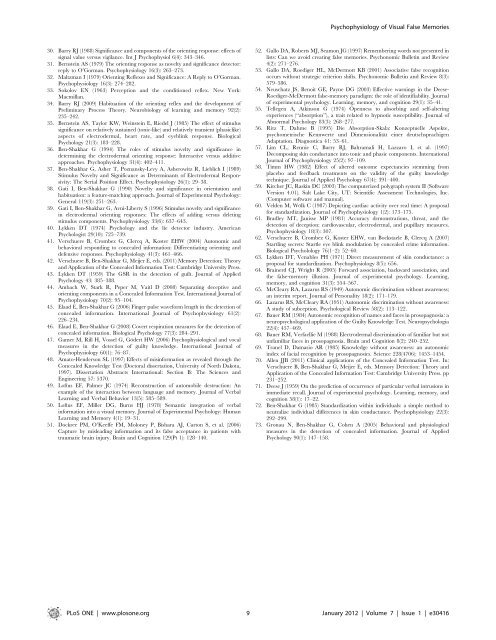
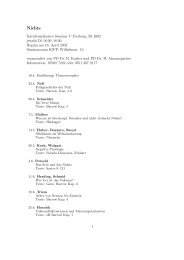
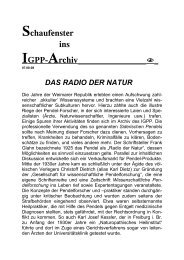
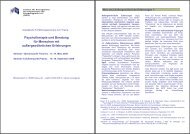
![Findliste Nachträge1 [pdf] - IGPP](https://img.yumpu.com/22552359/1/184x260/findliste-nachtrage1-pdf-igpp.jpg?quality=85)

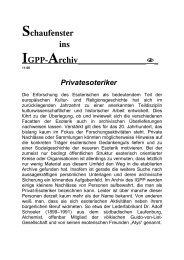
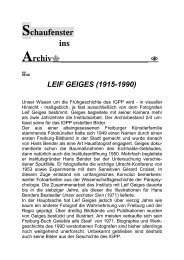
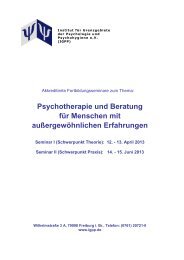
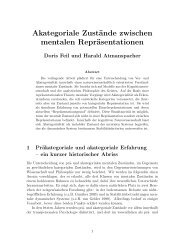
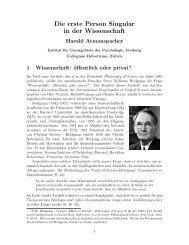
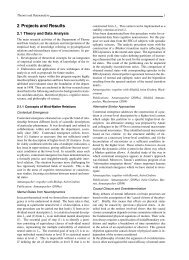
![Findliste [pdf] - IGPP](https://img.yumpu.com/22552265/1/190x245/findliste-pdf-igpp.jpg?quality=85)

